Sending this to Yeastspotting.
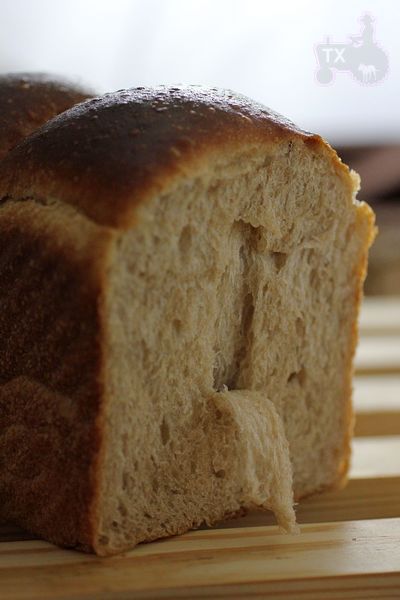
It's another variation for my favorite sourdough sandwich breads. This time there are 30% rye in the flour, 15% of which in levain, the rest in final dough. Before this loaf, I tried other rye ratios, 30% seems to be the sweet spot - enough rye flavor yet the dough is still strong enough to be soft, bouncy, and fluffy. The total flour amount is 280g for my Chinese pullman tin, which is 30g more than an all white flour sandwich dough. I knew I would need more dough to compensate for the rye, but 30 is much less than I anticipated, just shows that a bit of rye won't hurt the dough strength that much.
30% rye sourdough sandwich loaf
Note: 15% of the flour is in levain
Note: total flour is 280g, fit my Chinese small-ish pullman pan. For 8X4 US loaf tin, I suggest to use about 302g of total flour. For KAF 13X4X4 pullman pan, I would suggest using about 481g of total flour.
- levain
rye starter (100%), 12g
water, 19g
medium rye flour, 36g
1. Mix and let fermentation at room temp (73F) for 12 hours.
- final dough
bread flour, 196g (I used half KAF bread flour and half KAF AP flour for a balance of chewiness and volume)
medium rye, 42g
brown sugar, 28g
oil, 28g, softened
milk, 143g
salt, 6g
egg, 34g
1. Mix everything until stage 3 of windowpane (-30sec), see this post for details. 
2. Rise at room temp for 1 hours, punch down, put in fridge overnight.
3. Takeout, divide, round, rest for 1 hour. shape as instructed here for sandwich loaf.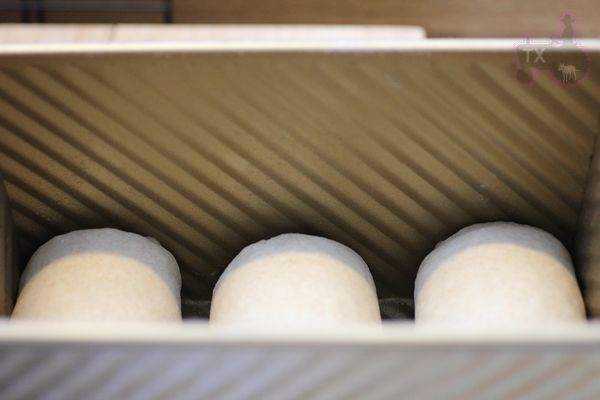
4. rise at room temp for about 5 hours. For my pullman pan, it should be about 80% full; for US 8x4inch pan, it should be about one inch above the edge. The dough would have tripled by then, if it can't, your kneading is not enough or over.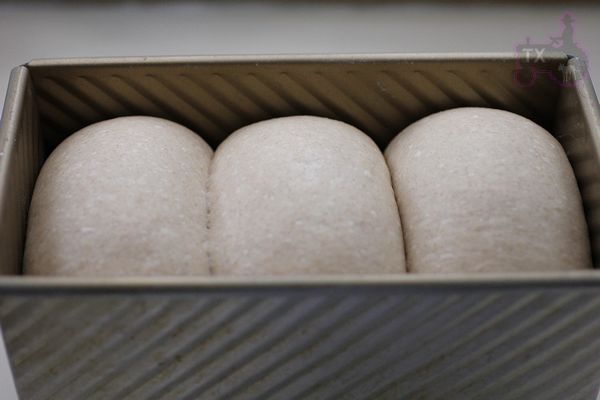
5. for sandwich loaf, bake at 400F for 15min, then 375 for 25-30min, brush with butter when warm. 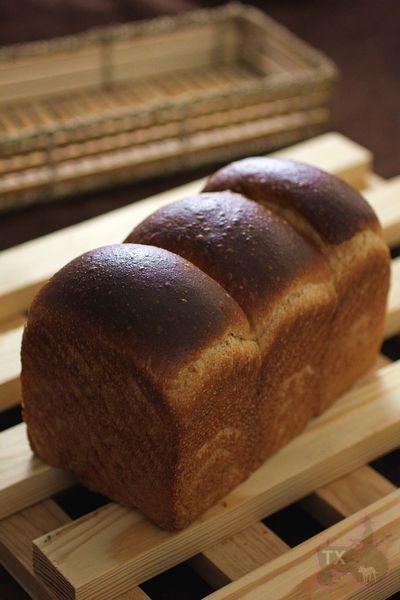
To counter the effect of rye flour, there needs to be enough tenderizing ingredients in the dough: oil, sugar, egg, milk all serve this purpose. The slices were extremely soft and fluffy, yet full of flavor.
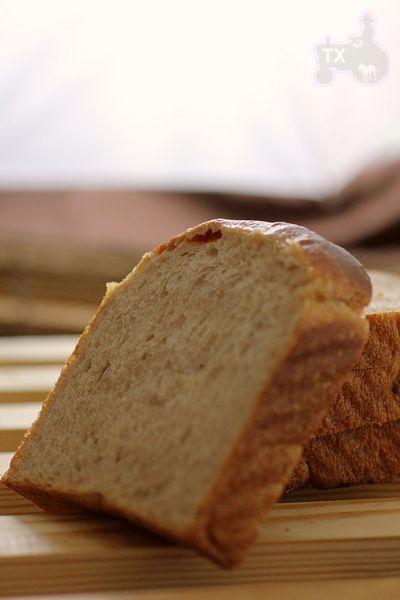
Used brown sugar rather than white sugar, oil rather than butter, to better complement the rye flavor
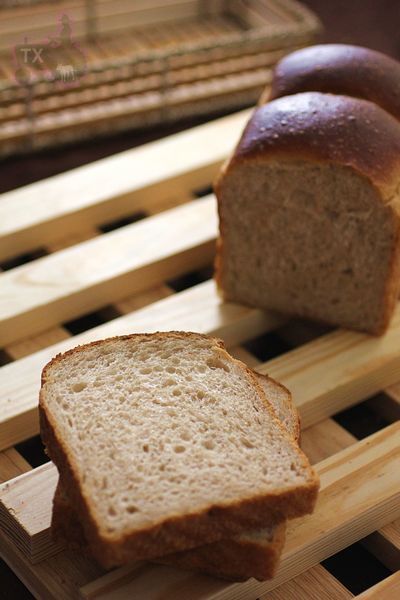
- txfarmer's Blog
- Log in to post comments
Beautiful!
I so much want a sandwich with that.
To some, medium rye means whole rye(link). To some, medium rye has some of the bran removed. So which type of medium rye did you use. What brand?
Thanks.
I mean this - look for General Mills Medium Rye Flour from the list:
http://www.nybakers.com/rye.html
Thanks.
Beautiful txfarmer. A unique combination of flours and techniques.
Eric
Thanks Eric! Haven't seen you around for a while, nice to catch up!
txfarmer,
Today I am working on one of Karin's formulas and Codruta's latest addition....I wonder if I can juggle 3 different formulas all in a day???
If it was earlier in the day I would do it but since it is mid-afternoon yours will have to wait until tomorrow :-) but the leaven....that I can begin to feed in preparation....
Thanks so much for posting this beautiful loaf with it's write up. I so appreciate all of your contributions here.
Take Care,
Janet
3 loaves a day would be quite ambitious! You house would be flooded by yummy breads.:)
Hi txfarmer,
What lovely bread, and wonderful to see a loaf using this much rye flour and still revealing a "high crown" finish.
I agree that 30% is the limit to go to to achieve flavour and dough performance.
Just noting you have sugar and oil at 10% and egg at 12% plus the use of milk. I think it is so instructive to see how these enriching ingredients can be used so effectively in a bread formula which many commercial companies mimic using a range of ridiculous additives. Great work!
I do wonder why you choose oil, however? Ordinarily, a fat with a higher melt point will create a protective coating around the chains of gluten developed from the intensive mixing. This gives greater tolerance in the dough during all the proof stage. Because oil is in a liquid rather than solid state, it does not afford the same benefits. Palm fat is a good substitute.
Very best wishes
Andy
Andy would butter or lard work as well?
I've never given any thought to the solids in milk when calculating hydration. I have measured it like water and not given it a thought. I'll have to stop myself next time I use milk and give it a thought. Thanks for waking me up on that.
Eric
I have made another similar loaf witih butter. Yes, it will work. The loaf was tall and yummy, but I thought the butter flavor competes with rye a little bit, which was why I switched to oil, knowing I would sacrafice some volume.
AB&P quotes that only 87% of milk weight is water, which has been proven to be a good rule of thumb for me.
Andy you ask the best questions! :)
Yes, I have also noticed butter and oil behave differently when it comes to gluten developement. Using the same amount, butter would yield a higher loaf. According to "Laurel's Kitchen Bread Book", if oil is used instead of butter, the amount would need to be doubled. Having said that, I chose to use oil here for a relatively "cleaner" flavor. I made a similar loaf with butter, but prefer this oil version since rye flavor is more noticable here.
Hi txfarmer,
For my regular day job, I would be expected to advise plant bakers seeking to create loaves that look as good as yours, but cannot include any of the enriching ingredients you use on grounds of cost alone!
The function of hard fat is that it forms a coating around the gluten strands which affords essential protection during and after the intensive mixing process, all the way through to baking. Oil does not work in the same way, as the fat has to remain solid in order to coat the gluten strands effectively. As I stated, palm fat works really well, as does vegetable shortening. Lard is the traditional bread fat, but is of animal origin, so no use to me as I don't eat meat or animal fats. Butter works quite well, but has a water content of 16 - 20%, so a relatively low melting point..but better than oil. You were quite correct to seek an alternative to butter, but a fat, rather than oil will definitely give better dough performance, and final loaf volume.
I don't understand the instructyion in the book you mention. It is well known that fat also has a de-naturing effect on protein. Why would you want to add more than is absolutely necessary in a formula such as this where finished loaf volume is so important?
All good wishes
Andy
Andy,
Very interesting discussion on fats used in formulas. Something I didn't know about.
You mention that a solid fat protects the gluten better than oil because it is a liquid.....I have noted that in certain formulas using butter some say to melt it while some say to simply soften it at room temp. If butter has been melted prior to being added to the dough will it loose some of it's protective properties?
Thanks for all the information you share here....all these 'little' details that make a world of difference in outcome!
Take Care,
Janet
I think in that book, which concentrate on 100% ww breads, she uses butter/oil to tenderize and soften the crumb, as well as keeping volume. By using double amount of oil, she says the volume of the bread would be similar to a dough that uses butter. What you are saying makes sense though.
Just a question, by palm fat, do you mean coconut solid oil, its similar in looks to shortening, but has a scent of coconut which doesn't taste in the finished product. I'm told to use it like regular shortening, but since I use lard mostly, am not doing very good with it! It does make a lovely grease to fry in, and I need to use it up, it was rather expensive, being bought at a health food store and never seen in a regular shop!
Hi Janet,
It really depends on what temperature the final dough ends up being mixed at, and then what temperature it is held at during any bulk plus final proof. Obviously, the higher the melt point of the fat used, the more effective it becomes in protecting the gluten network prior to it becoming de-natured and set in the oven cycle.
Best wishes
Andy
Andy,
Thanks for the answer to my inquiry. Makes perfect sense once I read what you offer about the temp. and melting point....I suspect that my kitchen - 31°c right now - and a bit of butter wouldn't be the ideal spot to ferment a dough whose gluten I would like protected as long as possible :-/.....
Take Care,
Janet
Lovely, txsfarmer! Interesting discussion about the use of fats. I knew that a fat that was solid at room temp was preferred but didn't know why. If I use a fat, I normally only add 6%. Can't remember where I got that figure from but was under the impression that was the ideal percentage to use. Too much, I was told, would shorten the gluten strands and, way too much and the final product would end up like cake.
Best,
Syd
6%? I really don't think it's the "ideal" or "max" ratio. For a lean hearth bread that doesn't get a lot of kneading, maybe, for a dough that's intensively kneaded, you can go MUCH higher. Think a brioche, a well kneaded one. I have gone as far as 100% butter to flour ratio, and the bread was nothing like cake, it was as light as cloud (see here: http://www.thefreshloaf.com/node/22245/100-butter-brioche-richer-bill-gates). The same goes for breads like pannetone. Or a lightly enriched bread like this soft sandwich loaf.
It's the kind of soft bread I'm searching. I hope my perception of the right level of gluten development will be correct in the week-end.
Good luck and dont' forget to show us how it turns out!
Another Inspiring variation of your Pan de mie, Txfarmer! Wonderful bread, and picture perfect.
you'll have many followers, now that you've included rye.
My attempts have yielded a very soft 25% rye that was good, but not really rye-y enough. A little caraway brings the fresh in-the-field rye taste, but not the underlying character of rye. My 40 and 50% versions had all the ryeness I could ask for, but they aren't a soft sandwich bread. I was planning a 33% rye, and this thread gives me hope. I shall pore over your methodology.
In reference to the fat conundrum, lipids end up replacing the protein film that surrounds the CO₂ bubble. Polar lipid molecules stabilize the gas bubbles to a greater degree than the proteins. From 0% to about 2% by weight, all fats reduces loaf volume. The hypothesis is that at these low levels, the film is mixed protein/lipid and is less stable than either alone. From 2% to about 10%, loaf volume increases with increased polar lipids. Non-polar lipids have a more deleterious effect on loaf volume as the amount of non-polar lipids is increased.
Generally polar lipids include saturated and monounsaturated fatty acids. Non-polar lipids include polyunsaturated fatty acids. Lard, butter, egg yolks, olive oil and coconut oil are high in polar lipids, as are all dairy; thus improve loaf volume. Canola (who can stand the taste anyway?), corn, sunflower and soybean oils, margarine, and vegetable shortening all have high levels of non-polar lipids, which reduce loaf volume.
This info gleaned from Bread Science, by Emily Buehler, and from private correspondence with Dr Buehler.
I don't address the protection and lubrication issues, as I don't know enough beyond anecdotal evidence to speak out.
cheers,
gary
Gary,
Thanks for this input on fats and bread. I am wondering if you have ever tried using coconut oil in a formula? I remember reading somewhere how it is one of the 'good' fats but haven't tried it in bread or anywhere else afraid the taste would impact the end product creating a loaf with coconut undertones.....
Janet
Being a good old suthren [sic] boy, I am not all that adventurous where my fats are concerned. Butter, lard, bacon drippings (which is flavored lard), and that newfangled olive oil are my staples. I do avoid, like the plague, hydrogenated oils like margarine and vegetable shortening, and highly polyunsaturated oils such as corn oil. I haven't had any compelling reason to try coconut or palm oil (are they the same?). The various fats do have their own flavors, but none except the drippings remind me of their origins. Corn oil doesn't taste like corn to me, nor olive oil taste of olives. I'd guess coconut oil has a unique flavor, but not necessarily of coconut. Why not buy a small bottle and make a 1lb./500g loaf for taste testing? And, of course, report back your results.
cheers,
gary
Gary,
Just after posting I was thinking I should give it a go. I did have some around the house years ago and it didn't get much use - can't even remember why now nor how it tasted....twas before my bread baking days.
Your suggestion coupled with my thought of doing the same = a unamous decision to put it on my weekly grocery list.....now to remember to follow up with results.....feel free to toss a reminder my way if I don't report back within a reasonable amount of time :*)
Janet
Gary,
Coconut loaf fresh out of the oven. Rise was high and held despite the fact that I let it go over the rim of my pan.....out running errands and it simply 'took off'. In the past, if this happens, the loaf has fallen a bit due to overproofing. Not today.
I got the regular coconut oil ( vs virgin ) that has been heated which, therefore doesn't have the coconut flavor at all. (I haven't tasted it as it is going to a friend who may or may not let me know how it tastes.....)
Janet
Most interesting, and informative.
I am finally happy to see someone who is NOT on the Canola bandwagon! I hate Canola and since Crisco started putting it into the mix of oils, I quit using it. Its not the taste so much, although its dead overcooked cabbage twang is disgusting. Its the smell, and the fact that if I use it, it makes my asthma kick in!
Pity poor me, its harvest time, and they are combining the canola fields around here, you get the rotten cabbage smell, and the dust! Talk about dust, canola raises more dust than any other field crop around here, and it STINKS!
Wonder how this would go using commercial yeast and buttermilk(instead of milk)?
Txf, do you use buttermilk much, in your bread baking?
I mostly bake with sourdough starter, which is already ... sour, so I don't usually use buttermilk, otherwise the acidity of the dough would be too much.
Random question, but I was wondering what type of stand mixer you use? I'm having a hard time making a decision as to which one to buy for myself....
Mine is KA 600, It's been working like a charm.
Hi txfarmer, I uploaded the pictures here. The bread is extremely soft and very flavorful. The dough was tacky, I was forced to oil my hands to shape it. Is the dough supposed to be manageable with hands alone?
I'm not sure the structure of the crumb is as cottoned as in your bread, but I have no complaints, really!
May I ask why you use such a firm rye preferment? It's really very tough to mix. Wouldn't a poolish serve the purpose equally well?
Looks great! A firm levain is better for volume, a poolish would make the dough more extensible - good for baguettes, not so good for tall sandwich loaves.
Txfarmer,
Why is a firm levain better for volume? Can't the final hydration be adjusted when using a poolish so the dough is firm?
For sandwich loaves what hydration level have you found to work the best for you when it comes to volume?
Take Care,
Janet
It's not the hydration of the dough, it's the hydration of the "levain" that matters. A firm levain (sourdough or not) is better for dough strength, which leads to higher volume. A liquid levain is better for dough extensiblilty, which is easier to stretch out (for baguettes).
txfarmer,
Thanks for the response.
Can you go into a more detail as to why it is the leaven's hydration level that matters as opposed to simply adjusting in the final dough? What is the 'science' behind it? That is what I don't understand.
Thanks,
Janet
Liquid levain has higher acidity, which reduce the dough gluten/strength.
Txfarmer,
This I did not know. Does it have more acidity because the liquid environment favors the bacteria over the yeast?
Janet
Yes. Not necessarily "over" the yeast, just better favors the bacteria than a firm starter.
Txfarmer,
An 'ahh-haa' moment. Thanks for the additional information!
Take Care,
Janet
Thanks ANdy, gary, and of course txfarmer for these enlightening posts. Can always count on the 'pros' to shed light.
I don't make enriched breads very often, and when i do, it's usually with butter (nothing beats its taste). But on the few occasions I substituted veg oil for butter, I thought they were less voluminous. Since i'm far from the scientific, disciplined sort, of course i never measured height or anything like that, so i just put it down to my mixing. However, i did notice when using olive oil, that it was less 'dense' than other types of vegetable oils.
now we know why, very interesting indeed. Is it any wonder then that palm oil and margarine are so commonly used in commercial baking. So if i'm reading Gary correctly, if using oils, 2% is the minimum.
Gary: coconut oil is totally different from palm oil. It's quite a controversial product. At one time, it was the darling of health experts then it sort of fell out of favour.
thanks all!
Made a yeasted buttermilk version, with poolish. It was everything I was hoping for, and more. About as soft and fluffy a bread as I have ever made.
Thanks.
[quote=ww]So if i'm reading Gary correctly, if using oils, 2% is the minimum.[/quote]At 2% by weight of any fat, loaf volume reaches its minimum, then starts back up. All natural fats have a mix of polar and non-polar lipids. While non-polar lipids reduce loaf volume, in practical use in real-world fats, they only subtract from the amount of lift provided by polar lipids. The ratio of the lipids is important; corn oil is among the worst, and butter is among the best.
Dr Beuhler's charts do not include literal values, as they are only representative of the range of lipid ratios. That was one of the reasons I contacted her. Those files are not available to me right now (on a different computer), but as memory serves, to assure extra volume due to fats, use at least 4–5% (more for oils, especially those high in polyunsaturates). At some point slightly greater than 10%, the effect levels off.
cheers,
gary
//edit typo
First I'd just like to say thanks for the amazing recipes, I've made this one a couple of times now and I'm always impressed with how soft the loaves come out, makes for perfect sandwich bread.
So I entered this recipe into a spreadsheet so I could play around with the total flour but I noticed my total rye percentage is at 17.3%, how did you calculate your 30%? I took into consideration the fact that I'm converting a white starter to rye over the course of 3 days so my starter contains a small amount of AP flour but even if I were to use 100% rye/water starter I'd still only be at 17.4%.
Total flour: (12/2)(half of starter)+36 (in levain)+196(bread flour in main dough)+42(rye flour in main dough) = 280g.
Rye flour: (12/2)(half of starter)+36(in levain)+42(rye flour in main dough) = 84g
rye radio: 84/280=30%.
Thanks for the explanation, I think I somehow forgot to reformulate the ingredients when I upped the total flour to 481g but I entered everything again from scratch and I'm getting 30% rye now. Can't wait for Saturday so I can try out this recipe!
I'm bringing this recipe up from the depths, because....
Holy cr@p! It's amazing! Scaled as instructed for a 13 x 4 x 4 Pullman loaf pan, and used a Polish rye flour from my local international market. Only tweak was adding 1tsp whole caraway seed and 1 tsp ground caraway. Otherwise followed recipe exactly as written. Highly recommend!
Even my super-picky boy-child requested this for every school lunch (salami and pb&j) until it was gone.
And grilled corned beef & Swiss? Mmmmm! So good!
This recipe will be in heavy rotation at Chez NimrodVern
Pix here: http://imgur.com/gallery/07BBpA9
Boy child requested salami sandwiches and pb&j sandwiches. Not salami&pb&j sandwiches!
... for the clarification. I'll eat p'butter on or with almost anything, but pb and salami was putting my stomach in a roil. :roll eyes:
gary
Having limited to no success with rye sandwich bread so far I’m excited to find this recipe and method. No more bricks for me, thank you very much. My other sourdough loaves are very nice, but with a high percentage of fresh milled rye flour and other fresh milled flours it’s hit or miss. Thanks very much, TxFarmer! Also hoping to keep this thread alive. Hope the links still work. New member here, so happy to find this group. Also from Tx, San Marcos. We could be neighbors…